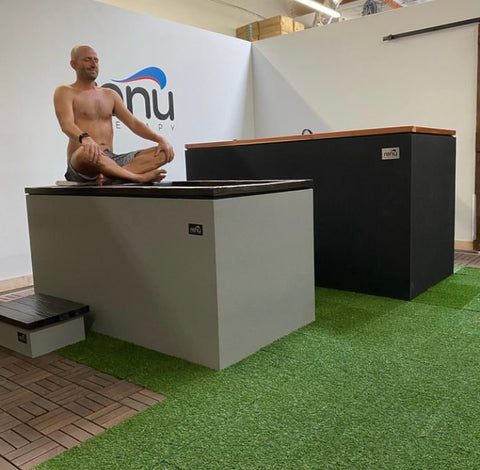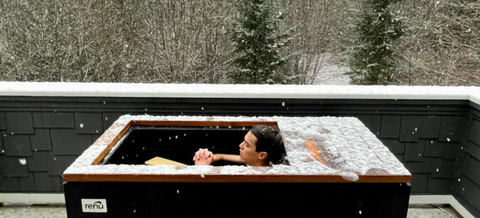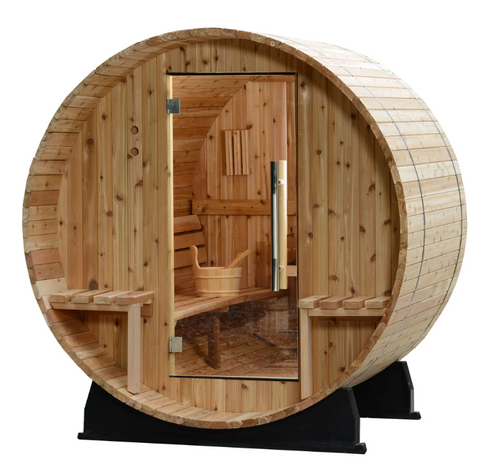Cold plunging and breathwork are two powerful practices that are gaining popularity in not only health and wellness circles but the mainstream. With both practices offering numerous benefits, it's no wonder why more people are turning to cold exposure and alternative therapies to treat various ailments and chronic disease, boost their immune system, or support a healthy lifestyle.

Plunging yourself in a cold bath for a few minutes a day and practicing a daily breathwork session can be highly effective tools to increase your mental, physical, and emotional well-being. Practicing both at the same time can be complementary and many cold water immersion enthusiasts make both a part of their daily wellness routine.
What is Cold Plunging?
Also known as cold water therapy or cold water immersion, cold plunging has been popular with professional athletes for years. It is now gaining popularity in the health and wellness world. The practice involves immersing yourself in an ice-cold water bath with cold temperatures of 50-60 Fahrenheit and submerging yourself for up to 10 minutes.
The practice and the extreme cold temperature of the water will likely pull you out of your comfort zone, especially if it is your first time! While the temperature change can cause an initial shock, allowing yourself to stay submerged for a few minutes actually provides you with numerous health benefits.
Rainn Wilson Reboots his Mind with Cold Water Immersion
Why Should I Practice Cold Water Immersion?
If you suffer from muscle soreness after an intense workout or simply want to increase your mood or energy, a freezing ice bath may be the perfect remedy. The benefits of cold water therapy include:
- Faster muscle recovery
- Less inflammation in the body
- Improved physical health
- Reduction of pain
- Improvement of circulation
- Resilence
- A boost of mood and energy
What is Breathwork?
When you practice specific breathing techniques or exercises, you are practicing breathwork. Becoming conscious of your breath and changing your breathing pattern is done through different breathing exercises and is practiced in yoga, meditation, and the Wim Hof method. Breathwork allows you to become more aware of the present moment, slows your mind and body down, and deactivates your sympathetic nervous system. For some, the practice can even be energizing and invigorating, allowing you to tap into new-found energy.
Why Should I Practice Breathwork?
Similar to cold plunging, breathwork boasts many benefits. From improved mental health to reduced stress, breathwork is a practice that has helped millions over thousands of years. Some benefits include the following:
- Improved immunity
- Mental and emotional healing
- Greater sense of self-awareness
- Confidence and happiness boosting
- Reduced anxiety and stress
- Pain relief
Incorporating Breathwork in Your Cold Plunge Practice
If you have dabbled in breathwork or cold plunging, but haven't tried both together, now is the time to do so! Both practices can support and enhance each other. If you aren't quite sure how to incorporate both, know that it's a good idea to practice breathwork before, during, and after your cold plunge.

Before Your Plunge
Before you jump into colder temperatures, make sure that you are connected to your breath. It's not very often during the course of your day that you take a moment, stop, and tune into your breath. Right before your cold plunge is the perfect time to do so. Use deep breaths in order to warm up your intercostal muscles and your whole body. Before your cold plunge:
- Make a conscious effort to connect to your breath
- Close your eyes if you would like
- Breathe in deeply through your nose
- Exhale slowly out of your nose or mouth
- Focus on a slow, deep, breath
- You can try Wim Hof Method Breathwork to improve your pain tolerance and focus before plunging in
During your Plunge
While you are in your cold plunge, it is important that you use your breath to stay calm and centered. Try these two breathing techniques during your cold immersion therapy:
- Take full in-breaths and pause: While you are in the plunge, take a full breath in through your nose. Pause for a few seconds, and then exhale. This technique of breathing can improve your circulation and your heart rate.
- Focus on your exhales: Breathing in increases your heart rate, while exhaling reduces your heart rate. Focus on your slow exhales while you are plunging in order to slow down your heart rate. Take a short breath in through your nose and then exhale slowly.
After Your Plunge
As you come out of your cold plunge immersion, your body temperature may drop, causing you to shiver or feel very cold. Combine fast breathing and slow breathing in order to warm your body up after exposing your body to freezing temperatures. Try the following after you step out of your tank:
- Take a few rapid breaths in order to warm up your body and intercostal muscles.
- Right after, take a few slow breaths in order to allow the warm blood to circulate around your body.
Wim Hof and Breathwork
If you have done a bit of research into cold plunging, you may have come across The Wim Hof Method. This extreme athlete came up with this method that is said to enhance one's health and vitality by practicing cold therapy, breathwork, and commitment. Wim Hoff believes in the power of the breath and that heightened oxygen levels greatly benefit the mind and the body. His specific breathing method offers the practitioner more energy and less stress and helps to improve pain tolerance and focus.
The Wim Hof Breathing Method
Wim Hof understands the potency of pairing breathwork with cold water immersion. You can try his breathing method right before jumping into your cold plunge pool filled with ice water, or even as a daily practice. His technique is as follows:
- Take 30-40 strong and fast breaths
- Hold your last breath in for as long as you can and then exhale
- Take slow and deep recovery breath
- Repeat the above steps 3 to 4 times
- At the end of your 3rd or 4th cycle, return to your normal rhythm of breath
Try Breathwork and Cold Plunging with RENU Therapy’s Cold Plunge Tanks
Life can be challenging. But with extra tools like breathwork and cold plunging, you can learn to stay calm, grounded, and focused even when faced with uncomfortable situations or challenging moments. Breathwork can prepare your body for cold therapy exposure and can positively set you up for the rest of your day. Similarly, the cold therapy method of regular cold plunging holds a host of mental and physical benefits; and when paired together, both practices support you in reaching your human potential and the highest version of yourself.

Interested to try cold plunging in a modern and stylish cold plunge tank? Try RENU Therapy's cold plunge tanks which can easily fit inside your home or backyard. Enjoy the convenience of having a cold plunge pool in your own home and make breathwork and cold plunging a daily practice. Want to learn more? Contact RENU Therapy today to learn more about our cold plunge tanks today!
















